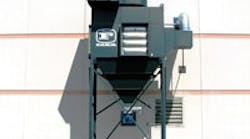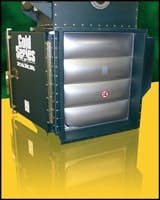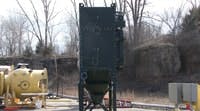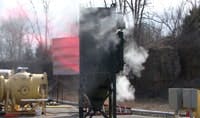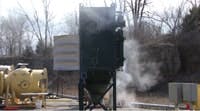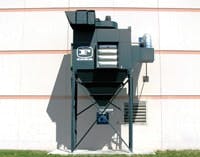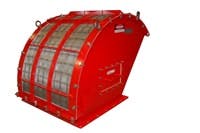Get Up-to-Date on Explosion Venting Requirements
Operations in many chemical plants can pose the risk of dust explosions. One common potential source of such explosions is a dust collection system. It’s therefore timely to examine the latest complete revision of the “National Fire Protection Association (NFPA) 68 Standard on Explosion Protection by Deflagration Venting” to see what’s changed and how this impacts future dust-collection decisions. The standard, which can be purchased online via the NFPA web site ( http://www.nfpa.org ), applies to all closed-vessel dry-collection systems such as cartridge-style dust collectors. So, here, we’ll share our understanding of five key implications of NFPA 68 as they relate to cartridge dust-collection systems.
1. NFPA 68 has changed from a “guideline” to a “standard.” It provides mandatory, and much more stringent, requirements for collection applications involving explosive dusts. This echoes actions by the U.S. Occupational Safety and Health Administration (OSHA), which recently launched a National Emphasis Program focusing on the safe handling of combustible dusts ( http://www.osha.gov/pls/oshaweb/owadisp.show_document?p_table=DIRECTIVES&p_id=3830 ). OSHA defines combustible dusts as “organic or metal dusts that are finely ground into very small particles, fibers, chips, and/or flakes…. Some of the industries in which combustible dusts are particularly prevalent include agriculture, chemical, textile, forest and the furniture industry.”
Simply stated, it’s the NFPA’s role to set the standard and OSHA’s and local authorities’ role to enforce it.
Most insurance policies and local fire codes state that NFPA standards shall be followed as code, so plants in nearly every town and county in the U.S. face a legal obligation to satisfy NFPA 68. The only exceptions would be where the authority having jurisdiction (AHJ) specifies another safety approach such as that of Factory Mutual (FM).
| Dust | Micron | Kst Value |
| Acrylonitrile butadiene styrene copolymer | 200 | 147 |
| Epoxy resin | 55 | 147 |
| Polyester resin with glass | 14 | 182 |
| Melamine resin | 18 | 110 |
| Phenolic resin | 10 | 129 |
| Polyamide resin | 15 | 105 |
| Polymethacrylate | 33 | 199 |
| Polystyrene (copolymer) | 155 | 110 |
| Polyurethane | 3 | 156 |
| Polyvinyl alcohol | 26 | 128 |
| Polyvinyl chloride | 125 | 68 |
| Dimethylaminophenazone | 10 | 337 |
| 2-Ethoxybenzamide | 100 | 214 |
| Paracetamol | 100 | 156 |
| Anthrachinon | 10 | 364 |
| Azodicarbonamia | 10 | 176 |
| Diphenol ketylene | 15 | 270 |
| Dicyandiamide | 10 | 9 |
| Pentaerythrite | 10 | 120 |
Table 1 -- Explosive Power of Various Dusts:
|
The new requirements hold major significance because many chemical plants now will have to install updated dust-collection/explosion-protection equipment to ensure regulatory compliance.
2. You now must determine whether a dust is explosive. In a closed vessel such as a cartridge dust-collection system, an explosion usually begins when a suspended cloud of combustible dust is present in high concentration within the collector. As the fan draws in large volumes of air, an outside spark or ember can be sucked into the collector, colliding with the dust cloud to trigger the explosion. The source of the spark may be a production process, a cigarette butt thrown into a hood (believe it or not, this really happens), or a static electricity discharge due to improper grounding of equipment.
To determine whether your dust is combustible, it must undergo explosibility testing in accordance with ASTM test methods. NFPA 68 stipulates that if a dust sample is available, it must be tested. The standard further states that it is the responsibility of the end-user (i.e., the plant or safety engineer) to commission the required testing and report results. Your dust collection supplier may ask you to supply a report of the test or, if unavailable, to provide in writing the explosive power (denoted as “Kst,” the pressure velocity) value that you know the dust doesn’t surpass.
Even if you believe you know the characteristics of your dust, a sample, if available, still must be tested under NFPA 68. After all, particle size may profoundly affect explosive properties. Take anthrachinon, for example: if its particle size exceeds 10 microns, the Kst value is estimated to be 91 bar-m/s. For particle size less than 10 microns, its Kst value is estimated to be 364 bar-m/s. This changes the classification of the dust.
Explosibility testing is the only way to know for sure and, therefore, is the only way to guarantee compliance. Several companies that specialize in explosion protection services offer this testing. You can opt to go directly to such a company or can commission the testing through your dust collection supplier.
Both NFPA and FM use this Kst value in formulas to calculate the amount of explosion vent area required for a dust collector. Class 1 dusts are below 200 Kst, Class 2 dusts range from 200–300 Kst, and Class 3 dusts are rated above 300 Kst. As a rule of thumb, when dusts approach 600 Kst, they are so explosive that wet collection methods are recommended. In addition to Kst, other important measurements that factor into the standard include “Pmax” (the maximum pressure in a contained explosion) and “Pred” (the maximum pressure developed in a vented enclosure during a vented deflagration).
Table 1 compares the Kst values of a number of common chemical dusts. A comprehensive compendium is available online at http://www.hvbg.de/e/bia/gestis/expl/index.html. This Web site contains a European database that lists the combustion and explosion characteristics of more than 4,000 dusts. The data provided, however, aren’t a substitute for the required dust testing.
Figure 1 -- Standard explosion vent:
This vent for 200 Kst dust is designed in
accordance with NFPA 68.
Figure 1 shows a standard explosion vent that has been sized for 200 Kst and manufactured to NFPA standards. For highly combustible dusts, vent sizing and ducting requirements become more complex and may require special calculations and equipment modifications to achieve compliance as we’ll discuss later.
3. You must commission a hazard analysis (also called a risk evaluation). Chapter 4 of NFPA 68 introduces a new hazard analysis requirement, stipulating that a plant will have to commission a risk evaluation for the dust collection system and keep the report on file, to show to the local fire marshal or other officials at a moment’s notice. It’s possible that some equipment suppliers or independent rep agencies may start to offer this service. Given how time-intensive the risk analysis is, however, we anticipate that a whole cottage industry of consultants will spring up to meet the newly created demand.
Figure 2 -- Staged explosion: After
explosion starts and pressure builds
within dust collector, vent opens to
relieve the pressure.
4. You now must maintain extensive documentation. A hazard analysis isn’t the only documentation required under NPFA 68. In Chapter 11, the standard outlines many other types of documents that now must be maintained to satisfy the local fire marshal or other AHJ. Section 11.2 lists 19 different types of documentation that must be kept on file. You can readily obtain some of these — such as manufacturers’ equipment data sheets, instruction manuals and specifications. Others — including a combustible material (dust) properties test report, user documentation of conformity with applicable standards, and employee training requirements — will present more substantial challenges to the plant or safety engineer in charge.
5. You now must schedule an annual inspection. Chapter 11 also stipulates that an inspection shall be performed on explosion venting equipment at least annually and possibly more often, based on documented operating experience. The objective of this inspection is simply to determine that all components of the system are correctly operating. Section 11.4 outlines a 16-point vent inspection with this objective in mind. The plant owner or operator also must verify in writing that the production process material hasn’t changed since the last inspection. You must file inspection reports with the other documentation listed in Section 11.2.
For inspections and documentation, responsibility again rests with the end-user. Although the new requirements are challenging for everyone, they will especially tax smaller processing facilities that don’t have dedicated safety personnel.
Design considerations The primary purpose of incorporating explosion venting in a dust collector is to save lives, not property. A well-designed explosion vent functions as a “weak element” in the pressure envelope of the equipment, relieving internal combustion pressure to keep the collector from blowing into pieces. Figure 2 depicts an actual staged deflagration in a dust collector equipped with explosion venting.
Explosion venting usually will save the collector from becoming a total loss, although major internal damage may occur. Nonetheless, if personnel remain safe, the explosion protection system has done its job. Collectors for combustible dust applications are typically, though not always, located outside and are designed to vent away from buildings and populated locations (Figure 3).
NFPA 68 includes several chapters of detailed information on design requirements for the use of explosion venting equipment. The most important areas of change and concern are:
Performance-based design option. Chapter 5 states that if there’s another method for protecting the device from explosions that’s acceptable to the AHJ, you can use that method instead of NFPA standards. You must document the design methodology and data sources and maintain them for the life of the dust collector.
An example of such a performance-based alternative is to actually explosion test a dust collector, instead of using the back pressure calculations in NFPA 68, to show that it will withstand certain pressure conditions. Using a combination of field testing and full-scale dust-collection laboratory test apparatus, we have performed such tests for explosion vent ducting applications. Our experience has shown that this approach can sometimes yield more accurate real-world performance data than the calculations provided in NFPA 68.
Vent ducting and sizing. For many years explosion vents were sized using simple ratios — i.e., a given dust collector volume needed one square foot of explosion vent area. However, the old formulas no longer apply. Instead, you must use the new design criteria set forth by NFPA 68. Chapters 7–9 provide the calculations for proper sizing of explosion vents, discharge ducts and other components. A reputable dust collector manufacturer will follow the equations for vent sizing in Chapter 8 and will be able to supply a calculations sheet that becomes part of the compliance documentation kept on file.
As far as vent discharge ducts, NFPA 68 stipulates in Chapter 6 that “Vent ducts and nozzles with total lengths of less than one hydraulic diameter shall not require a correction to increase the vent area.” For example, if an explosion vent has a hydraulic diameter of 40 in., you can use a 40-in.-long duct without any added back pressure consequences. However, a duct length above 40 in. (or whatever length is equivalent to the hydraulic diameter) requires stringent calculations to compensate for the estimated increase in back pressure to the collector.
Therefore, when you need longer ducts and the standard calculations cease to apply, you’ll have to work with your supplier to verify Kst values, duct lengths and strengthening requirements. The performance-based design option may come into play when designing collectors for such applications. Longer ducting usually will be needed if a collector must be located inside.
Figure 3 -- Typical installation: Cartridge
dust-collection system with explosion venting
usually is located outside, away from personnel.
That chapter also notes: “To prevent snow and ice accumulation, where the potential exists, and to prevent entry of rainwater and debris, the vent or vent duct shall not be installed in the horizontal position, unless any of the alternative methods in 6.5.2.3.1 are followed.” This means that if you’re using or considering a dust collector with horizontally mounted filter cartridges that have a horizontally mounted explosion vent, you might need to take extra steps to achieve compliance.
The accepted alternative methods of horizontal venting protection are fixed rain hats, weather covers mounted at an angle to shed snow, or deicing provisions such as a heated vent closure. Opting for one of these methods may necessitate additional safety components and testing. For example, if you use a weather cover, the standard says that restraints shall be used and shall be designed and tested to prevent the cover from becoming a free projectile. The other option is to eliminate horizontal venting altogether through use of a dust collector with vertically installed cartridges that use vertically mounted explosion vents.
Also new in NFPA 68 is a section allowing flameless venting inside buildings. Commercially available products in various configurations meet the standard. Flameless venting devices enable you to safely vent an explosion indoors without having any flame escape from the collector. Figure 4 shows a flameless device used to quench explosions. This is a viable option to ducted explosion vents but it’s not recommended for toxic applications, due to the risk of dust being released into the room where venting occurs.
Figure 4 -- Flameless venting:
The standard permits use of devices
that quench flames. Source: Fike Corp.
Here’re some useful questions to ask your suppliers and contractors:
• Is the explosion venting equipment manufactured by a company specializing in this area or is it home-made by the dust collection manufacturer? Either way, ask for documentation proving that the equipment complies with NFPA 68.
• Will the supplier provide a calculations sheet on vent sizing and vent ducting?
• Does the manufacturer have engineering and testing capabilities that allow use of the performance-based design option where needed?
• Can the supplier perform a hazard analysis or recommend a qualified consultant for this task?
• Can the supplier furnish alternative protection technologies such as flameless venting and explosion suppression (see below)?
• Is the installing contractor familiar with NFPA 68? There’s no formal certification for this, so you’ll have to inquire about specific experience and capabilities.
Explosion suppression and other protection methods. Applications where it isn’t feasible to duct an explosion to the outside through a wall or ceiling require an explosion suppression or suppression-isolation system. Such a system may cost more than the dust collector itself.
Suppression methods are covered in a separate document, “NFPA 69: Standard on Explosion Prevention Systems,” which also has been completely revised. Like NFPA 68, it has gone from a guideline to a standard. NFPA 69 extends beyond the scope of explosion venting to address the whole dust-collection system, i.e., inlet and outlet ducting, spark extinguishing systems, and methods for preventing an explosion from traveling back into the building.
Together, the two related standards will significantly impact the future design and cost of collection systems handling combustible dusts.
